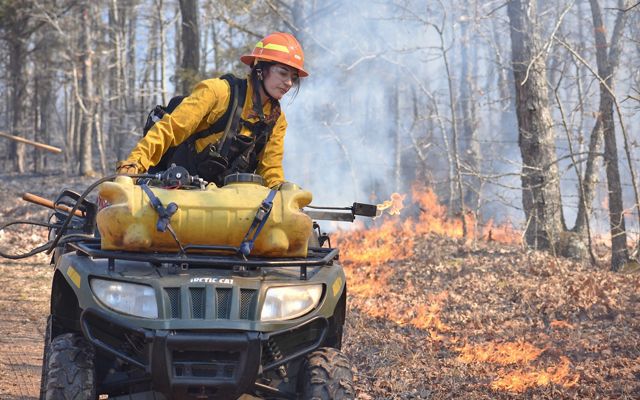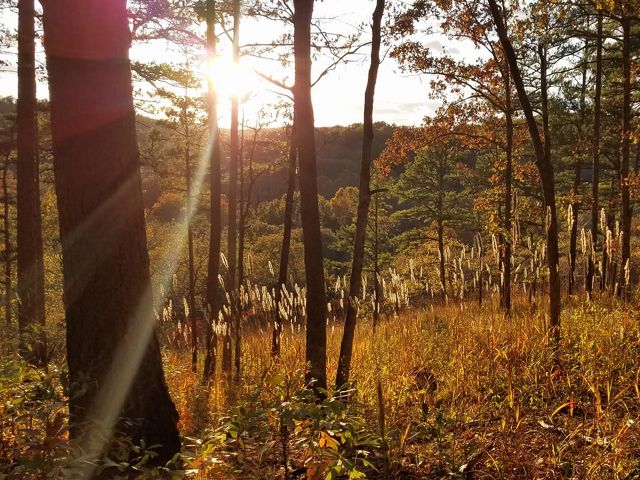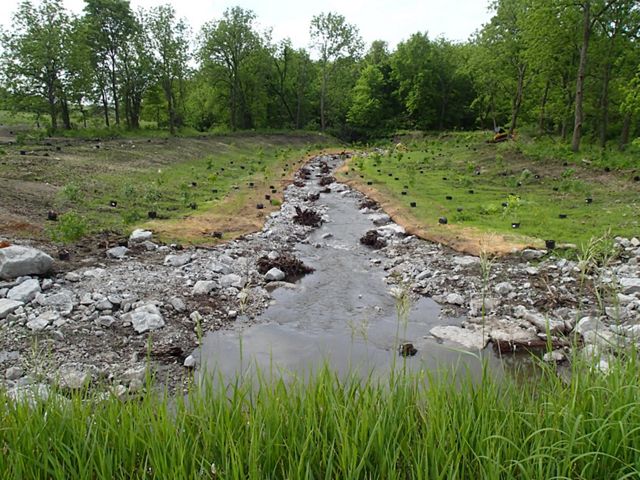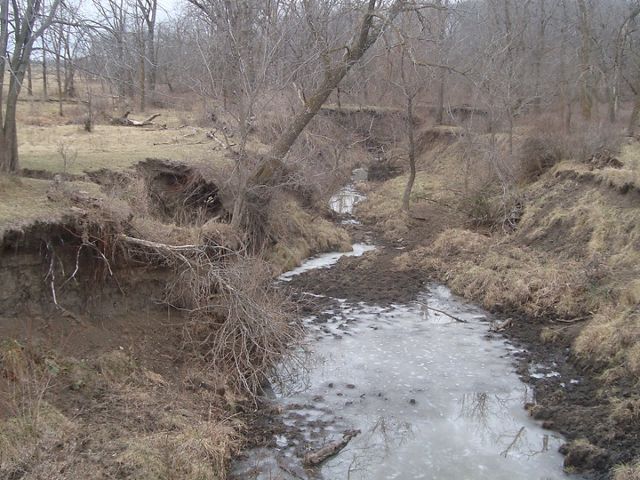Biodiversity Protection
Boosting biodiversity is at the heart of our mission. We're working across the state to protect habitats and species under pressure.
Boosting biodiversity is at the heart of The Nature Conservancy’s mission, and it has become even more urgent in recent years.
More than a third of America’s fish and wildlife species are now at risk of extinction. The abundance of butterflies has fallen 35%. Grassland birds are among the fastest-declining bird species in the United States, according to the North American Bird Conservation Initiative, with a 34% loss since 1970. Numbers are down. Mammals are struggling. Researchers point to multiple factors, but the combination of climate change with disappearing habitat has pushed even common species to narrowed landscapes.
Missouri is not immune. In a state that claimed 15 million acres of grasslands as recently as the mid-1900s, less than 1% of the prairie remains. Shifting conditions in freshwater streams have put the Neosho mucket and more than a dozen Missouri mussels on the federal endangered species list.
Fight for Survival - Podcast Episode
We discuss Missouri's endangered species and what's being done to save them.
Start StreamingThe issues can be overwhelming, but TNC in Missouri is continuously working on solutions. Whether it is using prescribed fire to restore vulnerable habitats, modeling fish-friendly stream crossings or caring for Missouri’s rare, remaining grasslands, the goal is to protect the variety of plant and animal life that is crucial to our future.
The real change comes through inspiring others and creating a roadmap of strategies and techniques people and communities across the state can use. Our projects are almost always scalable and replicable. We routinely work with partners to train and empower others to take the solutions we have helped develop and adapt them to make a difference in their communities.


Statewide Prescribed Fire
The Nature Conservancy is a world leader when it comes to using “good fire” to increase biodiversity and head off wildfires. You can see that work here in Missouri, where TNC burns more than 3,000 acres each year. Prescribed fire is an essential tool in conservation, one used by Indigenous peoples for thousands of years to care for natural habitats around the globe. It helps control invasive plants while also clearing away the dead leaves and brush that can pile up and fuel wildfires.
Lighting the Way - It's in Our Nature
Fire "lighters" Kylie Paul and Kelly Martin sit down with us for a special podcast episode
Start StreamingAlong with conducting prescribed burns on our own properties, TNC is deeply involved in training and partnerships with other agencies to promote responsibly managed fires across Missouri and beyond. We host a variety of prescribed fire workshops and events that are intended to give the next generation of fire practitioners the hands-on training to build a stronger, more diverse fire workforce that is committed to positive ecological outcomes.
Additionally, we’ve supported successful state legislation that makes it easier and safer for Missouri private property owners to conduct burns on their land or connect with professionals who can assist them to return this critical process back to the landscape.
Mill Creek - A Center For Conservation Innovation
The Mill Creek Center for Conservation Innovation packs the best parts of the Ozarks into its 163 acres.
Located north of Van Buren on the border of the Ozark National Scenic Riverways, the property is a collection of oak and pine woodlands, glades, springs, fens and riparian forests. Large rock outcrops, small bluffs and even a small shelter cave are found on site. More than 200 species of native plants surround the banks of its namesake, the crystal-clear Mill Creek.

Our work here carries forward the previous owner’s long-term restoration goals. Renata Culpepper, who along with her late husband, Bryan, is a dedicated conservationist, bought the land in 2012 and began to rehabilitate its natural features with help from TNC, Missouri Department of Conservation, the L-A-D Foundation, National Park Service and U.S. Forest Service.
TNC purchased the property in 2021. We have designated it as a cornerstone in TNC’s burgeoning network of Centers for Conservation Innovation (CCI) in Missouri. Like our first CCI at Dunn Ranch Prairie in Harrison County, the Mill Creek CCI creates a place where TNC can host researchers on-site and contribute to the study—and protection—of one of the world’s unique ecosystems.

Site Renewables Right
From our home in the central United States, Missouri sits in the heart of the region leading the way on renewable energy projects. To support the rapid expansion, The Nature Conservancy is creating tools to provide guidance. Our Site Renewables Right map launched in the spring of 2022 to help decision-makers find the best spots for wind and solar power locations.
TNC estimates there are roughly 120,000 square miles across 19 states that offer good opportunities for renewables—plenty of space for facilities or infrastructure in locations that limit potential conflicts with wildlife and important habitats. Estimates suggest as much as 75% of the country’s large renewable energy projects are coming to the central U.S. by 2050.
TNC’s ongoing efforts will help make that important work easier and protect vulnerable species, such as migrating birds and bats. The first-of-its-kind map puts the latest research and data on the best places to source renewable energy in the hands of companies and communities.


Restoration at Dunn Ranch Prairie
More than 20 years of The Nature Conservancy’s work come together at Dunn Ranch Prairie—a vibrant display of one of Missouri’s iconic native landscapes.
The tallgrass prairie brims with hundreds of species of plants and animals in Harrison County, near the Iowa border. Greater prairie-chickens perform their unmistakable "booming" every spring, upland sandpipers’ ghostly calls carry in the wind, regal fritillary butterflies alight on gorgeous coneflowers and bison roam across rolling hills. Grasslands are important not only for native species but also for people. They clean our water, protect us from flooding and store carbon in their roots.
Originally 2,281 acres, the site included 1,000 acres untouched by plow when TNC bought it in 1999 from descendants of the Dunn family. We’ve carefully restored the prairie surrounding that core habitat while knitting together additional properties, creating an expanse of 3,258 acres of tallgrass. People from all over the world come to experience the grasslands here.
The addition in 2017 of an adjacent TNC site, Little Creek Farm, with housing for visiting researchers further enhances Dunn Ranch’s power to promote conservation beyond its bounds. In 2021, Dunn Ranch became TNC’s first Center of Conservation Innovation in Missouri, our growing network of research hubs.
Fish Passage at Little Creek Farm
Flowing from its headwaters on The Nature Conservancy’s Dunn Ranch Prairie, Little Creek is one of the last places where you can find a tiny minnow called the Topeka Shiner. The Great Plains native was once plentiful in prairie streams, but the degradation of its habitat landed the shiner on the endangered species list in 1998. Erosion fills in the pools where shiners ride out inhospitable temperatures, and manmade barriers cut them off from food and mating grounds. But the damage is reversible.
In the spring of 2022, construction crews rebuilt Little Creek where it passes from Dunn Ranch through TNC’s Little Creek Farm in Harrison County. The project replaced erosion-carved banks with gentle slopes, assembled from layers of stones, earth and tangled tree roots. Freshly planted native grasses, shrubs and trees guard against future erosion and filter water running into the channel. Workers even built an underwater wedge at the lip of a culvert. Where water once plunged six feet off the edge, the stream flows at one level.
The change reconnected five miles of aquatic habitat for the shiner and offers a scalable model landowners can use to fight erosion and protect their properties.

Focus on Osage Plains
Once the defining landscape of North America, native prairies have disappeared from all but a few pockets of the country. The Nature Conservancy in Missouri recognized early on the need to safeguard and restore what was left. Our Wah’Kon-Tah Prairie, pieced together through more than four decades of work, is now the largest protected prairie complex in the Osage Plains.
Spanning 4,040 acres outside of El Dorado Springs in eastern Missouri, Wah’Kon-Tah is a model of the stunning biodiversity of tallgrass prairies. You might hear prairie mole crickets trumpeting courtship calls at twilight or see Upland plovers, Henslow's sparrows and scissor-tailed flycatchers grace the airways. Deer, coyotes, fox and the eastern cottontail forage among the asters, goldenrods, gentians, coneflowers, big bluestem and little bluestem.
We work with the Missouri Department of Conservation to keep this remnant of our natural landscape in balance. That includes collecting thousands of pounds of seeds used to restore parts of the Osage Plains each year. Regular prescribed burns prevent invasive shrubs and trees from taking over. In their place every spring, you’ll find sprays of wildflowers.
Protecting Missouri's Endangered Species
Bringing back the Topeka shiner
In partnership with the Missouri Department of Conservation, TNC launched an effort in 2013 to restore the Topeka Shiner—a federally endangered fish species—into the headwaters of the Grand River Grasslands in northern Missouri.
Restoring the prairie chicken population at Dunn Ranch Prairie.
For over seven years, TNC has been working with conservation partners and neighboring states to restore a healthy prairie chicken population to Missouri. The program has had success protecting prairie chicken feeding and mating habitat at Dunn Ranch Prairie.
Returning the American burying beetle to Missouri soil
On June 5th, 2012, American burying beetles became the first federally endangered species to be reintroduced in Missouri. Prior to this reintroduction, the beetles hadn't been seen in the state since the 1970s.


